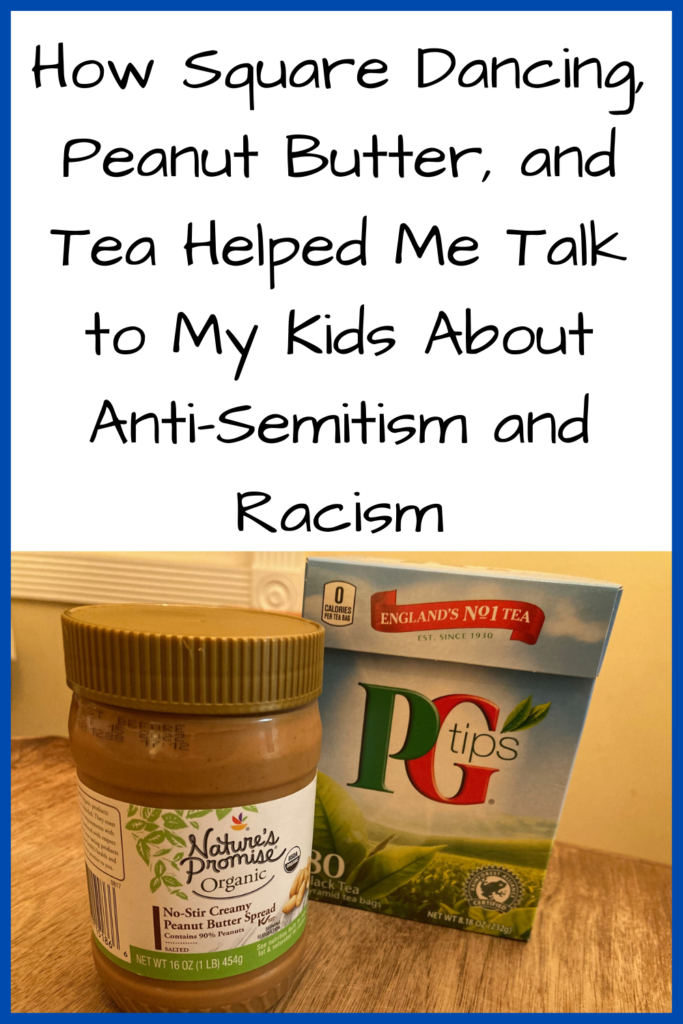
I started telling my husband something, but like always, my kids were listening. My kids are always listening, unless it involves something we need them to do.
I was telling my husband about how I had answered a question on Facebook – one that the original poster probably meant as a hypothetical. I said, “So they asked, ‘Why did we all have to learn square dancing?’ It was probably meant as a joke, but I replied – in all seriousness – “Because of racism and anti-Semitism.”
Behind me, I heard a small voice ask, “What’s anti-Semitism? And what’s square dancing?” I wasn’t planning on having that conversation right then. But it’s often best to talk about these hard topics as they arise naturally.
“Anti-Semitism is when someone doesn’t like Jewish people. Square dancing is this type of old folk dancing. Henry Ford was this guy who was super rich and really hated Jewish people. He also hated jazz, which was created and made famous by Black people. And for some reason, he thought that jazz was being made popular by Jewish people. So he thought that if he made square dancing popular, that it could push out jazz. So he gave a bunch of money to people to develop lessons about square dancing. Later on, someone else who thought like him took those lessons and encouraged high schools to adopt it. Which is why a lot of high schools have you learn square dancing in gym class.”
My two kids sat on that for a moment. I muttered an aside to my husband: “Heck, racism explains a lot of things.”
Of course, my kids heard (again). “What do you mean?” asked my older son, who is eight.
“That lots of things have history that have to do with racism.”
“What about peanut butter?” he asked, as he finished eating his PB&J sandwich.
“Well, not that one,” I said. I then remembered a bit of history. “But actually, yes! George Washington Carver was a Black man who had studied a lot about agriculture. After the Civil War, when the people who had been enslaved became free, they got the land with really bad soil because white people didn’t allow them to have the land with good soil. The South relied on cotton crops, which are really bad for the soil, so a lot of it was really messed up. George Washington Carver taught them how to make the soil good for growing again. He was also really into peanuts, because they had a lot of protein and could help restore the soil. So he made peanut butter popular.”
I had only recently learned of Carver’s big contributions to sustainable agriculture. Since our family gardens using many of the same principles, it was fun to share that with them.
But my older kid wasn’t done yet. “What about tea?” he said, eyeing my favorite beverage. I drink several cups of it a day. I think he thought he was getting a one-up on me.
“Oh God, yes. I drink British-style tea, which they got from India. Except the English took over India and took their tea, along with a bunch of other stuff. They also treated the people there really badly,” I explained.
As my younger son’s attention was flagging, I thought it might be good to get to some type of point. I told them, “It’s okay to like things that have hard histories. But you have to know about those histories and deal with them.”
So many of the injustices perpetuated in our systems are because adults can’t come to grips with this simple truth. They don’t even want to have the straightforward historical conversations that I just had with my kids. Perhaps more importantly, they don’t just avoid having those conversations at home, but banning those conversations from schools. That’s what banning “critical race theory” (which is actually a framing of legal theory relevant to law and policy grad students) is about – no one is teaching kindergarteners actual critical race theory. These grown adults look history in the face and then look away, denying it completely.
But our schools owe our kids more than that, especially Black and Indigenous kids. We owe our children more than that. All it takes to get the conversation started is kids’ natural curiosity about how the world is the way it is.